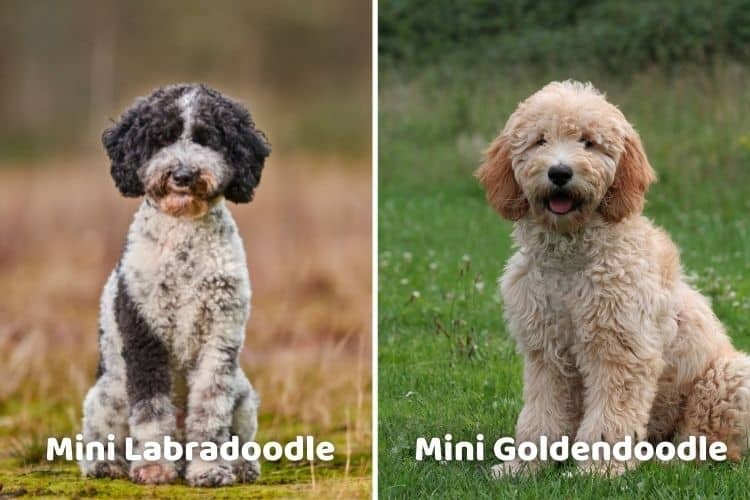
The rising popularity of designer dog breeds has made mini Goldendoodles and mini Labradoodles highly sought-after pets. These intelligent, affectionate breeds combine the hypoallergenic qualities of miniature Poodles with the beloved traits of Golden Retrievers and Labrador Retrievers respectively. While sharing many similarities in size, temperament and grooming needs, these doodle varieties have distinct characteristics that can influence a family's choice. This report analyzes the key differences between mini Goldendoodles and mini Labradoodles across various aspects including personality, trainability, health considerations and care requirements to help prospective owners make an informed decision.
Comparison of Mini Goldendoodle vs Mini Labradoodle
Breeding and Generations
While both breeds are crosses between a Miniature Poodle and either a Golden Retriever or Labrador Retriever, the breeding generations can impact traits significantly. According to breeding information, the key generations include:
Mini Goldendoodle generations:
- F1 (50% Golden/50% Poodle)
- F1B (25% Golden/75% Poodle)
- F2 (F1 x F1 cross)
- F3 (F2 x F2 cross)
- Multi-generational (F3+)
Mini Labradoodle generations:
- F1 (50% Lab/50% Poodle)
- F1B (Labradoodle x Poodle)
- F2 (F1/F1B x Poodle)
- F2B (F2 x Poodle)
- F3B (F3 x Poodle)
- Multi-generational
- Australian (includes Cocker Spaniel genes)
Coat Types and Colors
According to breed characteristics, there are distinct differences in coat variations:
Mini Goldendoodles typically have:
- Longer, wavy fur
- Limited color range (golden, cream, apricot, red)
- More consistent coat texture between generations
Mini Labradoodles feature:
- Shorter, wirier fur texture
- Broader color spectrum (black, chocolate, red, cream, white, yellow)
- More coat texture variation between generations
The coat type impacts grooming needs and hypoallergenic properties, with F1B generations of both breeds being most consistently hypoallergenic.
What are Mini Goldendoodles and Mini Labradoodles?
Origins and Size Characteristics
While both breeds emerged from crossing miniature Poodles with retrievers, according to breed information, Mini Goldendoodles have been around since the mid-1990s, while Mini Labradoodles date back to the 1960s. Mini Goldendoodles typically stand between 13-20 inches tall and weigh 15-35 pounds. Mini Labradoodles are slightly larger at 14-21 inches tall with similar weight ranges. Both breeds come in teacup and toy variations:
Teacup varieties:
- Under 11 inches tall
- Under 13 pounds
Toy varieties:
- 14-15 inches tall
- Under 20 pounds
Intelligence and Training Aptitude
According to breed characteristics, both breeds demonstrate high intelligence but exhibit different learning styles. Mini Goldendoodles are notably quick learners and highly trainable, making them excellent choices for first-time dog owners. They excel at learning basic commands and tricks due to their eager-to-please nature.
Mini Labradoodles display strong problem-solving abilities and can master complex tasks. They are particularly adept at:
- Service dog training
- Therapy work
- Advanced obedience training
- Agility courses
While both breeds are intelligent, Mini Labradoodles tend to be more task-oriented in their learning approach, while Mini Goldendoodles are more focused on pleasing their handlers through training exercises.
Health and Care Considerations for Mini Doodle Breeds
Common Health Issues and Preventive Care
While both breeds can inherit health conditions from their parent breeds, according to breed health information, Mini Goldendoodles are more prone to eye-related issues like cataracts and glaucoma, as well as sebaceous adenitis and subvalvular aortic stenosis. Mini Labradoodles tend to have a higher predisposition to hip dysplasia.
Preventive care recommendations differ between the breeds:
Mini Goldendoodles require:
- Regular eye examinations
- Heart health monitoring
- Skin condition checks
Mini Labradoodles need:
- Hip and joint evaluations
- Ear infection prevention
- Thyroid testing
Lifestyle and Exercise Requirements
According to breed characteristics, while the previous sections covered general exercise needs, specific activity requirements vary. Mini Goldendoodles tend to expend energy through following family members and indoor play, requiring structured exercise mainly for mental stimulation. Mini Labradoodles have a stronger drive for purposeful physical activity and need:
- Designated outdoor exercise time
- Swimming opportunities
- Interactive play sessions
- Task-oriented activities
Mini Labradoodles typically maintain higher energy levels into adulthood compared to Mini Goldendoodles, who become more relaxed with age.
Conclusion
Mini Goldendoodles and Mini Labradoodles, while similar in their Poodle-cross heritage, exhibit distinct characteristics that may influence a potential owner's choice. The key differences lie in their physical attributes, with Mini Goldendoodles typically having longer, wavier coats in golden to red hues, while Mini Labradoodles feature shorter, wirier fur in a broader color spectrum. Mini Labradoodles tend to be slightly larger and maintain higher energy levels into adulthood, requiring more structured physical activity and task-oriented exercise. In contrast, Mini Goldendoodles are generally more relaxed and eager to please in training situations.
These findings suggest that Mini Goldendoodles may be better suited for first-time dog owners or families seeking a more laid-back companion, while Mini Labradoodles might be ideal for active households or those interested in service/therapy work. Both breeds require regular health monitoring, though they face different genetic predispositions - eye issues being more common in Mini Goldendoodles and hip problems more prevalent in Mini Labradoodles. When choosing between these breeds, potential owners should carefully consider their lifestyle, exercise capabilities, and willingness to meet each breed's specific grooming and health maintenance needs.